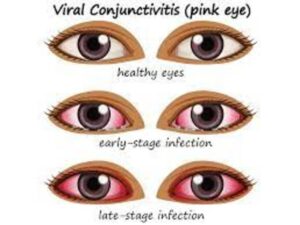Can a fart give you pink eye?
Can a fart give you pink eye?
Can a fart really give you pink eye? It might sound like a myth or a joke, but there’s some truth behind this quirky question.
Pink eye, or conjunctivitis, is an infection or inflammation of the eye’s conjunctiva, typically caused by bacteria, viruses, or allergens.
While the bacteria that lead to pink eye aren’t typically airborne in the way farts are, direct contact with bacterial particles – including those from fecal matter – can potentially cause infection.
So, while a fart itself won’t give you pink eye, poor hygiene after exposure to bacteria might raise the risk.
Here do chickens fart?
Can a fart give you pink eye?
While it’s a common myth, a fart itself won’t directly give you pink eye, but there is a slight link when it comes to hygiene.
Pink eye, or conjunctivitis, is an infection of the conjunctiva caused by bacteria, viruses, or allergens. The bacteria responsible for pink eye often come from sources like fecal matter, which contains particles that could lead to infection if transferred to the eyes.
However, passing gas releases air and odor, not bacteria that can float through the air to infect your eye. Pink eye typically spreads through contact – for instance, if someone touches fecal particles, then touches their eyes without washing their hands.
So, while the act of farting isn’t a risk factor, poor hygiene after using the bathroom can be. Practicing good handwashing habits is the best way to prevent this bacterial form of conjunctivitis from spreading.
Can you get pinkeye from a fart?
No, you cannot get pink eye, or conjunctivitis, directly from a fart. Pink eye is caused by bacteria, viruses, or allergens that infect or irritate the conjunctiva of the eye.

Although some bacteria that cause pink eye are found in fecal matter, they don’t spread through the air in a way that would make a fart infectious. Instead, pink eye typically spreads through direct contact. For instance, if someone comes into contact with fecal bacteria (like on an unwashed hand after using the restroom) and then touches their eye, it can lead to bacterial conjunctivitis.
The myth likely stems from the fact that poor hygiene, especially after bathroom use, can transfer bacteria to the eye area. So, while farting itself poses no risk for pink eye, maintaining clean hands and practicing good hygiene are essential steps to avoid bacterial infections, including conjunctivitis.
Here, how do you say fart in Spanish?
Can you get pink eye from poop particles?
Yes, it is possible to get pink eye, or conjunctivitis, from exposure to fecal bacteria, which can be present in poop particles. Pink eye often develops when the eye’s conjunctiva becomes infected or irritated by bacteria, viruses, or allergens.
Fecal matter contains bacteria like E. coli and Shigella, which can lead to bacterial conjunctivitis if they come into contact with the eyes.
However, pink eye doesn’t spread simply through the air. Instead, the bacteria typically transfer through touch, meaning someone who has fecal bacteria on their hands (from poor bathroom hygiene, for example) can introduce it to their eyes if they rub or touch them.
This is why thorough handwashing after using the restroom is essential. Keeping hands clean can significantly reduce the risk of bacterial conjunctivitis, as it prevents these bacteria from reaching the eye area and causing an infection.
What are the main causes of pink eye?
Pink eye, or conjunctivitis, is primarily caused by viral infections, bacterial infections, allergens, or irritants.
Viral conjunctivitis, often linked to the same viruses that cause the common cold, spreads easily through respiratory droplets or contact with contaminated surfaces. It’s typically contagious and causes watery discharge and redness in the eyes.
Bacterial conjunctivitis, caused by bacteria like Staphylococcus aureus or Streptococcus pneumoniae, also spreads through direct or indirect contact. Symptoms include redness, swelling, and a thick, yellow-green discharge.
Poor hygiene can increase the risk, as bacteria from sources like hands or contaminated objects can transfer to the eyes.
Allergic conjunctivitis occurs in response to allergens like pollen, dust, or pet dander and isn’t contagious. It usually causes itching, redness, and watery eyes. Lastly, irritant conjunctivitis can result from exposure to smoke, chemicals, or foreign particles, leading to eye discomfort and redness but isn’t infectious.
Can wind cause pink eye?
Wind itself doesn’t directly cause pink eye, but it can contribute to conditions that lead to conjunctivitis, especially in dry or dusty environments.

Here, does gas X makes you fart?
When wind carries dust, pollen, or other small particles, these irritants can enter and irritate the eyes, potentially leading to a form of conjunctivitis called irritant conjunctivitis. This type of pink eye isn’t contagious but can cause redness, watering, and discomfort.
Additionally, wind can dry out the eyes, making them more vulnerable to irritation or infection. If someone rubs their eyes to relieve discomfort caused by wind, they may inadvertently transfer bacteria or viruses from their hands, increasing the risk of bacterial or viral conjunctivitis.
To minimize these risks, it’s helpful to wear protective eyewear in windy, dusty conditions and to avoid touching the eyes without washing hands, reducing the chance of infection or irritation.
When your eyes get pink?
Eyes can turn pink or red due to a condition called conjunctivitis, commonly known as pink eye. This happens when the conjunctiva, the thin, transparent layer covering the white part of the eye, becomes inflamed. Pink eye can result from viral or bacterial infections, allergens, or irritants.
Viral and bacterial conjunctivitis are contagious and often spread through direct or indirect contact with infected individuals or surfaces, leading to symptoms like redness, itching, swelling, and discharge.
Allergic conjunctivitis, on the other hand, is triggered by allergens such as pollen, pet dander, or dust. It causes similar symptoms but isn’t contagious.
Additionally, irritants like smoke, chemicals, or even strong winds can lead to red, irritated eyes. In all cases, the eyes appear pink or red because of increased blood flow to the inflamed blood vessels in the conjunctiva. Practicing good hygiene and avoiding allergens can help prevent pink eye.
It’s a myth can a fart give you pink eye
Yes, the idea that a fart can give you pink eye is indeed a myth. Pink eye, or conjunctivitis, is caused by bacteria, viruses, allergens, or irritants coming into direct contact with the eyes, but it doesn’t spread through the air from a fart.
Farts consist mainly of gases without the bacteria needed to cause an eye infection. However, the myth likely stems from the fact that fecal bacteria can cause bacterial conjunctivitis if transferred to the eyes through poor hygiene.
For instance, if someone has fecal bacteria on their hands after using the bathroom and then touches their eyes, they could potentially develop pink eye. So, while a fart itself isn’t a risk factor, not washing hands thoroughly after bathroom use can be.
Good hygiene, including regular handwashing, is key to preventing bacterial conjunctivitis and reducing the spread of other infections.
What to do when you eyes get pink
If your eyes become pink, the first step is to identify the possible cause and manage the symptoms to avoid spreading infection if it’s contagious.
For bacterial or viral conjunctivitis, which are contagious, practice good hygiene by washing your hands frequently, avoiding touching your eyes, and using separate towels or pillowcases to prevent spreading it to others. Avoid wearing contact lenses until your eyes are fully healed.
Here, how to make fart someone while sleeping?
To relieve discomfort, use a cool or warm compress on the eyes, depending on what feels soothing. For bacterial pink eye, you may need antibiotic eye drops prescribed by a doctor, while viral conjunctivitis typically resolves on its own within a week or two.
If the pink eye is due to allergies, antihistamine eye drops can help reduce symptoms like itching and redness. Always consult a healthcare professional if symptoms worsen or don’t improve, as they can help guide the right treatment.
5 Reason your eyes get pink
Here are five common reasons why your eyes might become pink:
1. Viral Conjunctivitis
Viral conjunctivitis, often referred to as “pink eye,” is caused by viruses, such as adenovirus, that can infect the eye’s conjunctiva. It spreads easily through contact with infected surfaces or respiratory droplets from someone who is sick. Symptoms typically include redness, itching, watery discharge, and sometimes sensitivity to light.

Viral conjunctivitis is highly contagious but generally resolves on its own within one to two weeks. To prevent spreading it, avoid touching your eyes, wash your hands regularly, and refrain from sharing personal items like towels or makeup.
2. Bacterial Conjunctivitis
Bacterial conjunctivitis is caused by bacteria, such as Staphylococcus or Streptococcus, which can infect the eyes and lead to pink or red discoloration. This form of pink eye often produces thicker, yellowish discharge that can make the eyelids stick together, especially in the morning. Bacterial conjunctivitis is also contagious and can spread through contact with contaminated surfaces or objects.
Treatment typically involves antibiotic eye drops prescribed by a healthcare provider, and practicing good hygiene helps reduce the spread. Without treatment, bacterial conjunctivitis may persist longer than viral forms and potentially worsen.
3. Allergic Conjunctivitis
Allergic conjunctivitis occurs when the eyes react to allergens like pollen, pet dander, dust, or mold. This type of pink eye is not contagious but is characterized by red, itchy, and watery eyes. Seasonal allergies often trigger this reaction, especially during times when pollen counts are high. Antihistamine eye drops or oral antihistamines can provide relief, reducing inflammation and irritation.
Avoiding exposure to known allergens can help prevent symptoms. Rinsing the eyes with cool water or using lubricating eye drops can also help alleviate discomfort caused by allergens.
4. Irritant Conjunctivitis
Irritant conjunctivitis happens when the eyes come into contact with irritants, such as smoke, chlorine from pools, or harsh chemicals. These irritants can cause redness, a gritty feeling, and watery eyes but are not contagious.
The irritation generally subsides once the irritant is removed, and symptoms usually resolve on their own. Flushing the eyes with clean water can help remove the irritant and provide relief. Avoiding environments with smoke, chemicals, or other eye irritants and wearing protective eyewear in harsh conditions can help prevent this type of conjunctivitis.
5. Dry Eye Syndrome
Dry eye syndrome occurs when the eyes don’t produce enough tears or when tears evaporate too quickly, causing redness, irritation, and sometimes a gritty sensation. Environmental factors like wind, air conditioning, or screen time can exacerbate dryness.
Here, how to handle a fart in yoga class?
Chronic dry eye is not contagious but can be uncomfortable and lead to red or pink eyes. Lubricating eye drops, also known as artificial tears, are commonly used to relieve symptoms. In more persistent cases, a healthcare provider may recommend prescription eye drops or lifestyle adjustments, like reducing screen time or using a humidifier.
Related faq’s
Can you get pink eye from a fart on your pillow
While it may sound unusual, you could theoretically get pink eye from fecal bacteria that might be present if someone passes gas near your pillow, especially if the gas is accompanied by particles from the gastrointestinal tract.
However, the risk is extremely low. Pink eye, or conjunctivitis, is primarily spread through direct contact with infected surfaces or bodily fluids. It’s more common to contract pink eye through contact with contaminated hands or objects.
Practicing good hygiene, like washing your pillowcases regularly and avoiding touching your face after contact with unclean surfaces, significantly reduces the risk of infection.
How do you get pink eye
Pink eye, or conjunctivitis, can be contracted in several ways, depending on its cause. Viral conjunctivitis spreads through direct contact with infected individuals or contaminated surfaces.
Bacterial conjunctivitis also spreads through contact, often from touching the eyes with unwashed hands or sharing personal items like towels. Allergic conjunctivitis is triggered by allergens such as pollen, dust, or pet dander, and is not contagious. Irritant conjunctivitis results from exposure to chemicals, smoke, or foreign particles.
To prevent pink eye, maintain good hygiene, avoid touching your eyes, and stay away from known allergens and irritants.
Can you get pink eye from poop in a pool?
Yes, it is possible to get pink eye from fecal matter in a pool, although the risk is relatively low. When someone with a fecal contamination in a pool comes into contact with the water, bacteria can enter the eyes, potentially leading to bacterial conjunctivitis.
Additionally, if a person accidentally ingests contaminated water and then touches their eyes without washing their hands, they could introduce bacteria and develop pink eye. To reduce the risk, it’s essential to practice good hygiene, such as showering before swimming, avoiding swallowing pool water, and ensuring that pools are properly maintained and sanitized.
Can you get pink eye from a dog fart?
No, you cannot get pink eye directly from a dog fart. Pink eye, or conjunctivitis, is caused by infections (viral or bacterial), allergens, or irritants affecting the conjunctiva of the eye. While dog farts can contain bacteria and other particles, they do not carry the pathogens that directly cause pink eye.
However, if a dog has an infection, there may be bacteria in its fecal matter, which can be present if a dog is in close contact with you or your belongings. If someone were to come into contact with fecal matter from the dog and then touch their eyes without proper hygiene, there could be a risk of developing bacterial conjunctivitis.
Maintaining good hygiene, such as washing your hands after handling pets and avoiding contact with their fecal matter, is essential to prevent infections. Overall, while a dog fart itself poses no risk for pink eye, being mindful of hygiene is crucial.
Here, does birds fart
Pink eye from poop treatment
Treatment for pink eye caused by fecal bacteria, or bacterial conjunctivitis, typically involves a few key steps to relieve symptoms and eliminate the infection.
First, it is essential to consult a healthcare professional for a proper diagnosis. They may prescribe antibiotic eye drops or ointments to combat the bacterial infection. It’s crucial to follow the prescribed dosage and complete the entire course of medication, even if symptoms improve before finishing the treatment.
In addition to medication, maintaining good hygiene is vital. Wash your hands frequently and avoid touching your eyes to prevent further irritation or spreading the infection.
Applying a cool compress to the eyes can provide relief from discomfort and reduce swelling. If symptoms worsen or do not improve within a few days of starting treatment, revisit your healthcare provider for further evaluation.
Avoid wearing contact lenses until the infection has cleared, and replace any contaminated items, like towels or pillowcases, to prevent reinfection.
How long can pink eye live on sheets
The bacteria or viruses that cause pink eye, or conjunctivitis, can survive on sheets and other fabric surfaces for varying lengths of time, typically ranging from a few hours to several days.
The exact duration depends on the type of pathogen and environmental conditions, such as humidity and temperature.
Bacterial conjunctivitis pathogens may persist on surfaces for longer periods compared to viruses. For instance, common bacteria like Staphylococcus can survive on dry surfaces for days, while viral particles, such as those from adenovirus, can remain infectious for several hours to a few days.
To reduce the risk of spreading pink eye, it’s important to wash sheets, pillowcases, and towels regularly in hot water and detergent. Avoid sharing personal items, and practice good hygiene, such as frequent handwashing, to minimize the chance of infection. If someone in your household has pink eye, it’s best to wash and sanitize surfaces frequently to limit the spread of pathogens.
Pink eye headache fatigue
Experiencing headaches and fatigue alongside pink eye can be concerning, as these symptoms may indicate a more extensive viral infection or underlying condition.
Viral conjunctivitis, the most common type of pink eye, often accompanies respiratory infections like colds or flu. These infections can lead to systemic symptoms such as headaches, fatigue, and general malaise.
Additionally, the discomfort from pink eye, including irritation, sensitivity to light, and redness, can contribute to headaches. Straining to see clearly due to blurry vision can also cause tension headaches.
Fatigue may result from the body’s immune response as it fights off the infection, diverting energy and causing feelings of tiredness.
If you experience persistent headaches and fatigue with pink eye, it’s essential to consult a healthcare professional for proper diagnosis and treatment. They can determine whether the symptoms are part of a broader viral infection or if another issue needs to be addressed, ensuring effective management and relief.
Pink eye headache and nausea
Headaches and nausea accompanying pink eye may indicate an underlying viral infection, such as a cold or flu, which commonly causes viral conjunctivitis.
The body’s immune response to the infection can lead to systemic symptoms, including headaches and nausea.
Additionally, discomfort from pink eye, such as light sensitivity and eye strain, may exacerbate headaches. If nausea is severe or persistent, it’s important to consult a healthcare professional, as it could signal a more serious condition. Proper diagnosis and treatment are essential to address both the pink eye and any related symptoms effectively.
Conclusion
In conclusion, the notion that a fart can give you pink eye is largely a myth.
While it is theoretically possible for fecal bacteria to be present in the air or on surfaces following a fart, the actual risk of contracting pink eye from this source is minimal. Pink eye primarily spreads through direct contact with infected bodily fluids, contaminated surfaces, or allergens.
To prevent pink eye, practicing good hygiene, such as regular handwashing and avoiding touching the eyes, is far more effective than worrying about the unlikely transmission from a fart. Maintaining cleanliness is key to eye health.



